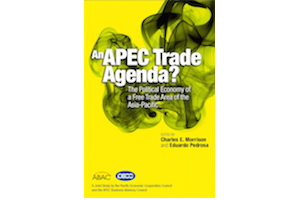 An APEC Trade Agenda? The Political Economy of a Free Trade Area of the Asia Pacific
An APEC Trade Agenda? The Political Economy of a Free Trade Area of the Asia Pacific
Edited by Charles E. Morrison and Eduardo Pedrosa
First Published in 2007 by ISEAS Publishing
A Joint Study by the Pacific Economic Cooperation Council and the APEC Business Advisory Council
The proposal for an Asia-Pacific-wide free trade agreement is one of the oldest ideas for promoting mutually beneficial regional cooperation dating back to the mid-1960's. In more recent times, the idea has found new support for two main reasons: as a plan B to the stumbling Doha Development Agenda (DDA) round of WTO negotiations; and as a solution to the noodle bowl of bilateral agreements in the region.
This report assesses the political feasibility of the Free Trade Area of the Asia-Pacific (FTAAP) proposal and looks at alternative modalities for achieving free trade and investment in the Asia-Pacific. The report includes trade policy perspectives from the three largest economies of the region: the United States, China and Japan, lessons from similar proposals such as the Free Trade Area of the Americas (FTAA), possible convergence among the many preferential trade agreements (PTAs) in the region, and alternative approaches to regional economic integration.
- An APEC Trade Agenda
- A free Trade Area of the Asia Pacific in the Wake of the Faltering Doha Round: Trade Policy Alternatives for APEC
- The Political Economy of a Free Trade Area of the Asia Pacific: A U.S. Perspective
- The Political Economy of a Free Trade Area of the Asia Pacific: A China Perspective
- Japan's FTA Strategy and a Free Trade Area of the Asia Pacific
- Lessons from the Free Trade Area of the Americas for APEC Economies
- Prospects for Linking Preferential Trade Agreements in the Asia Pacific Region
- ASEAN Perspective on Promoting Regional and Global Freer Trade
